Wildflowers of the Great Smoky Mountains
More than 1400 species of wildflowers are native to the Great Smoky Mountains. Every spring in late April Great Smoky Mountains National Park is the site of the week-long annual spring wildflower pilgrimage [1] to celebrate this diversity. The park is also the site of the All Taxa Biodiversity Inventory [2] to inventory all the living organisms in the park. This article lists some of these Wildflowers of the Great Smoky Mountains and references sites for further research.
Threats
Plant poaching is a major threat in the park. In particular, ginseng is a popular target. Removal of specimens such as trilliums and orchids for private gardens is also threatening these populations.[3] The hemlock woolly adelgid has destroyed most of the hemlocks within the park. The Emerald ash borer is also very destructive of native tree species.
Air pollution is also injurious to native plant populations in the park.
Examples
| Image | Latin name | Common names |
|---|---|---|
 | Aquilegia | Granny's bonnet or Columbine |
 | Asclepias quadrifolia | Fourleaf milkweed or whorled milkweed |
 | Carex plantaginea | seersucker sedge or plaintainleaf sedge |
 | Caulophyllum thalictroides | Blue cohosh |
 | Chamaelirium | Blazing-star, Devil's bit, False unicorn, Fairy wand, or Helonias |
 | Claytonia virginica | Eastern spring beauty, Virginia spring beauty, or fairy spud |
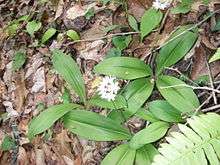 | Clintonia alleghaniensis | White Clintonia, Clinton's Lilly, Speckled Wood Lily |
 | Conopholis americana | Squawroot |
| Cymophyllus fraserianus | Fraser's sedge | |
 | Cypripedioideae | Yellow Lady Slippers |
 | Delphinium tricorne | Dwarf larkspur |
 | Dicentra canadensis | Squirrel Corn |
| Dicentra cucullaria | Dutchman's Breeches | |
 | Dicentra eximia | Bleeding heart |
| Diervilla sessilifolia | southern bush honeysuckle | |
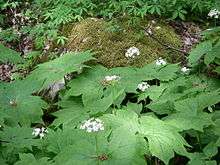 | Diphylleia cymosa | |
 | Dodecatheon meadia | Shooting stars |
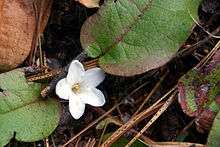 | Epigaea repens | mayflower or trailing arbutus |
 | Euonymus obovatus | Running strawberry bush |
 | Hexastylis arifolia | little brown jug |
 | Hexastylis virginica | Virginia heartleaf |
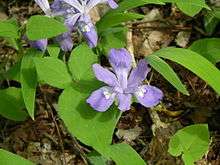 | Iris cristata | Dwarf Crested Iris or Crested Iris |
 | Lycopus americanus | Water horehound |
| Maianthemum racemosum | Treacleberry or feathery false lily of the valley | |
 | Micranthes micranthidifolia | Lettuceleaf saxifrag, branch lettuce, or brook lettuce |
 | Mitchella repens | Partridge berry or squaw vine |
 | Monarda didyma | Bee balm |
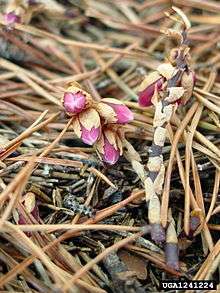 | Monotropsis odorata | Sweet pinesap or pygmy pipes |
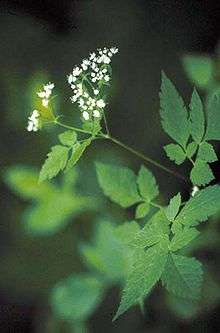 | Osmorhiza claytonii | Clayton's sweetroot |
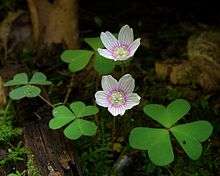 | Oxalis montana | mountain woodsorrel, wood shamrock, sours, white woodsorrel |
 | Panax quinquefolius | American ginseng |
 | Penstemon canescens | Eastern gray beardtongue |
 | Phacelia bipinnatifida | Fernleaf phacelia, or spotted phacelia |
 | Phacelia fimbriata | Fringed phacelia |
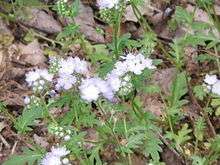 | Phacelia purshii | Miami mist |
.jpg) | Prosartes lanuginosa | Yellow mandarin, or yellow fairybells |
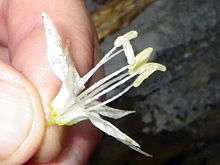 | Prosartes maculata | yellow mandarin, spotted mandarin, or nodding mandarin |
 | Rhododendron calendulaceum | Flame azalea |
 | Rugelia nudicaulis | Rugel's Indian plantain or Rugels ragwort |
 | Sanicula smallii | Small's blacksnakeroot |
 | Sedum | Stonecrop |
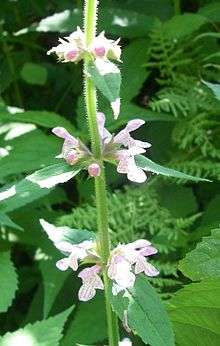 | Stachys clingmanii | Clingman's hedgenettle |
 | Synandra hispidula | Guyandotte beauty |
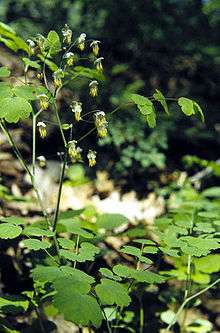 | Thalictrum dioicum | Quicksilver-weed |
 | Thalictrum thalictroides | Rue anemone |
 | Trillium catesbaei | Bashful wakerobin or rosy wake-robin |
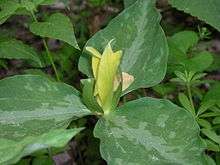 | Trillium luteum | Yellow wakerobin or yellow trillium |
 | Trillium vaseyi | Sweet wakerobin or sweet beth |
| Viola appalachiensis | Appalachian blue violet, Appalachian violet, or Henry's violet | |
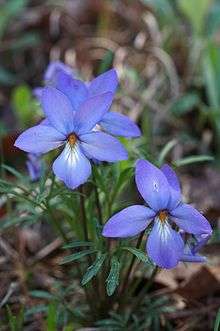 | Viola pedata | Birdsfoot violet, bird's-foot violet, or mountain pansy |
.jpg) | Viola rotundifolia | roundleaf yellow violet |
| Xanthorhiza simplicissima | Yellowroot |
See also
- Wildflowers of New England
- Wildflowers of the Canadian Rocky Mountains
- List of San Francisco Bay Area wildflowers
- Lady Bird Johnson Wildflower Center
- Brandywine Wildflower and Native Plant Gardens
Resources
- Great Smoky Mountains Wildflowers: When & Where to Find Them (Paperback)by Carlos C. Campbell, Aaron J. Sharp, Robert W. Hutson, William F. Hutson, Windy Pines Pub,(April 1996),ISBN 0-9643417-3-5
- Wildflowers Of Tennessee, The Ohio Valley and the Southern Appalachians (Paperback)by Dennis Horn and Tavia Cathcart, Lone Pine Publishing (2005), ISBN 1-55105-428-0
References
External links
- Species Mapper
- Tennessee Native Plant Society
- North Carolina Native Plant Society
- Official Smokies Nonprofit Wildflower Hikes
- Official Smokies Nonprofit Wildflower Books and Information